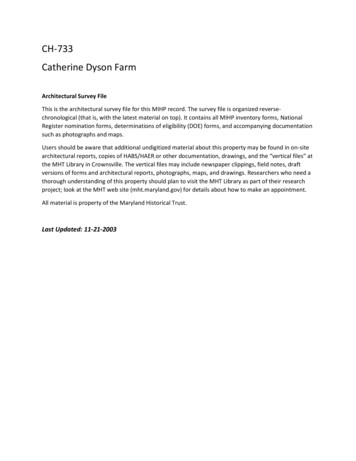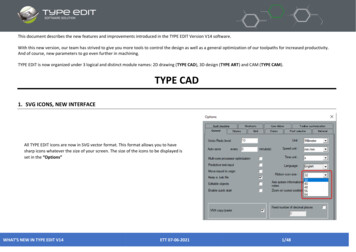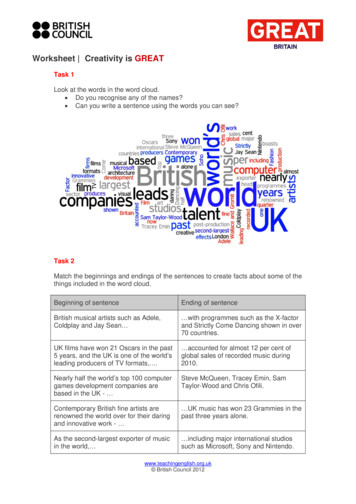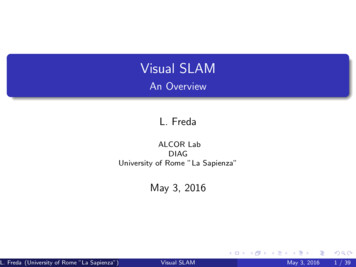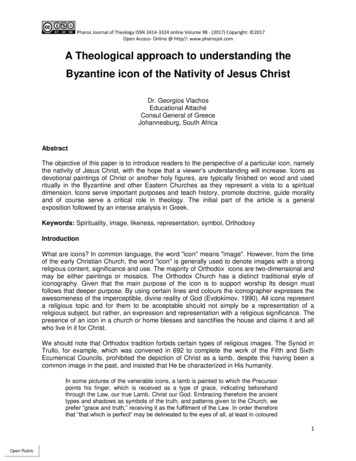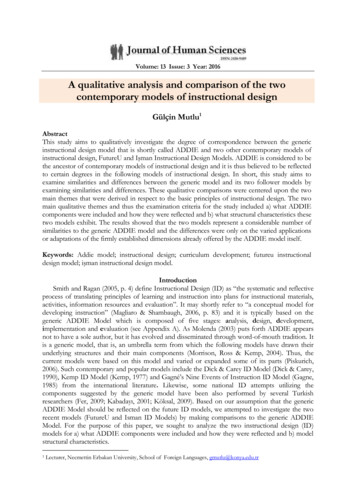Transcription
ContemporaryDESIGNICONS
FrankensteinContemporaryDESIGNICONSselected by James Dyson2020
ContentsIntroduction8Rotring Engineering Pencil34Foreword10Design Museum, London36Geodesic Dome38Dyson Research, Designand Development centre12RB211 Engine40Concorde14John Hancock Center, Chicago42Hovercraft16Wink Chair44Citroën DS18Heron Parigi Drawing Board46DCO2 Clear20Art Museum, Denver48Challenge of Materials Bridge22Austin Morris Mini50Sony Walkman24JCB Digger52Moulton Bicycle26Eames Lounge Chair54MacLaren Buggy28Toio Lamp56Gaggia Espresso Machine30A-POC, A Piece Of Cloth58B306 Chaise Longue32Picture Credits60
“ For me, design is abouthow something works, nothow it looks. It’s what’sinside that counts. ”James Dyson
James DysonBorn in 1947, Dyson attended Gresham’s School in his home city ofNorfolk, followed by the Byam Shaw School of Drawing andPainting and then the Royal College of Art, which are both inLondon. While training as a product designer at the RCA, he gainedseveral commissions and his work won a number of awards.From 1970, he spent four years managing the marine division ofBath-based engineering company Rotork, before starting his owncompany. The revolutionary Ballbarrow was his major invention ofthis period, winning a Building Design Innovation award.Awarded the CBE in 1998, James Dyson became the first engineerto give the prestigious Dimbleby Lecture for the BBC in 2004.James Dyson was Chairman of the Design Museum for 5 years,has won numerous awards including Designer of the Decade,Entrepreneur of the year, and the European Design Prize. Jamessits on a number of design boards, including council member of theRoyal College of Art, director of Imperial College, London, Museumfur Angewandte Kunst (MAK) Vienna, and Member of IndustrialDesign Society of America.James Dyson sold his shares in Ballbarrow in 1978 to fund thedevelopment of the dual cyclone vacuum cleaner. Over the next fiveyears, he built more than 5,000 prototypes, before he succeededwith G-Force in 1983. The DCO1was launched in 1993 and quicklybecame the best-selling vacuum cleaner in the UK. Dyson productsare now exported around the world and the company won aQueen’s Award for Innovation in 2003.89
Foreword“ I have not failed. I've just found 10,000 ways that won't work. ”Thomas A. EdisonSome years ago, through pure frustration, I resolved to make a better wheelbarrow. And then a better vacuum cleaner. And then abetter washing machine. My intention was to create products thatserved their purpose better than anything else available.In that respect, I wanted to follow the path of my hero, IsambardKingdom Brunel. In 2004, BBC viewers voted Brunel the greatestBriton ever after Churchill, so I am not alone. Yet his profession –engineering - is not particularly highly regarded. Design used tomean bridges, railways, purpose. Personally, I don’t see the difference between designers and engineers. They are one.10Most people only consider how something was designed if it doesn’t work. Real design works. The best products evolve as part of adesign process, in which the technology on the inside informs theway that they look on the outside. The success of companies suchas JCB and Rolls-Royce Aerospace illustrates the importance ofkeeping technology and innovation at the heart of design. For thesame reason, the Citroen DS, with its many technological patents,innovative suspension system and inimitable shape is inspireddesign and can stand shoulder to shoulder, or bumper to bumper,alongside cars designed today.For me, design is about how something works, not how it looks. It’swhat’s inside that counts. The best designs come from someonequestioning everything. Designers, engineers look at the samethings as everyone else. But they see something different. Andthey think what could be – and make it happen .even if it takes5,127 prototypes to succeed.James Dyson11
Dyson RDD centre1998 Chris Wilkinson ArchitectsUp above, windows in a wavyroof allow lightto penetratedeeply. Morefunctional thana flat roof, itdisperses rainwater throughsmall pipes,which literallysuck the wateraway. It canalso be easilydisassembledallowing newbuildings to bebolted on.12Too many working environments, whether they areoffices or factories, are dull, uninspiring or downright ugly. They may be designed to be functional,but many fail even in that respect. Little wonder somany people hate work.James Dyson was determined to be different.Chris Wilkinson’s design for the Dyson Research,Design and Development Centre in Malmesbury,Wiltshire is intended to make the workingenvironment inspiring. The building yells innovation andexcitement. It says “great place to work”. Indeed, it is designedto attract high-calibre people,the best in their fields, and makethem want to stay. A building can do as much towards creatinga happy environment as the people it contains.Chris Wilkinson was asked to create a space that would reflectboth Dyson's creativity and the surrounding landscape. So dividersdo not separate workspaces, keeping the interior flexible and,wherever possible, open plan. As in any competitive business,there are secure areas, but they are not oppressive.The building reflects Dyson’s philosophy of cleanliness, freshnessand efficiency delivered through robust systems
Concorde1969 BAC/SudThe Sovietanswer to theConcorde –the ill-fatedTupolev Tu 144– was dubbed“Concordski”by the everimaginativeBritish press.Fuel ispumped fromone part ofConcorde toanother, maintaining theaircraft’s flightbalance as thetanks empty.British prestige suffered plenty of blows duringthe early 1960s. Among them was the abruptcancelling of the entire programme for developingsupersonic combat aircraft. One allied project didgo ahead, however – and was to inject a big doseof pride into the national psyche.The BAC/Sud Concorde was revolutionary inmany ways. It carried commercial passengersat speeds much faster than sound (up to Mach 2,in fact). It boasted a stunningly beautifuldouble-delta wing formation with no need fora tail. And – perhaps most amazing of all –it was developed simultaneously in two sites,Toulouse in France and Filton in the UK.Both prototypes embarked upon their maidenflights on the same day in 1969, provoking muchpublic euphoria. Concorde’s commercial successwas to be limited by high running costs, but itsslender, elegant shape (accompanied by the harshroar of its afterburners) soon became a familiar andenchanting sight in British skies.14
Hovercraft1959 Christopher CockerellIn Canada,speciallyadaptedhovercraft areused to breakice onwaterways.The main obstacle to speedy travel – on water orland – is drag. One neat answer to this problem offriction, first researched in the 1870s, was to floatthe vessel concerned on a cushion of compressedair. Thus, it does not touch the water, but hoversabove it.A hovercraftcan be steeredby rudders,propellers orsmall doors inthe skirt called“puff ports”.No practical breakthrough came, however,until the 1950s, when the British scientistChristopher Cockerell devised the firstsuccessful Air Cushion Vehicle or “hovercraft”.His SRN-1 created a sensation when it waslaunched in 1959. Gas turbine engines poweredHovercraft the lift fans, which sucked in air and forced it downcan’t go into a space beneath the vessel. This air cushionup-hill.was contained within a flexible rubberised skirt.Driven forward by aircraft propellers, the hovercraftwas highly manoeuvrable and could reach speedsof over 100 km/h (62 mph). A larger model, capableof carrying over 400 passengers and 60 vehicles,soon established itself as an alternative (and lessnauseating) ferry across the English Channel.16
Citroën DS1955 CitroënThe Citroën DSneeded noconventionaljack when awheel had tobe changed.The pneumaticsuspension didthe job.The launch of the Citroën DS19 staggeredthe motoring world in 1955. It was, simply,the most technically advanced saloon car everseen. To enhance the effect, Citroën christenedit the “Goddess” or “Déesse” – hence DS.For a start, the DS looked extraordinary. At thefront, the nose sloped to a point. Where was theOne air intake? At the back, the bodywork curvedunfortunate down to the bumpers and enclosed the rearside-effect of wheels. The steering wheel had a single spoke.the DS’s rollingsuspensionfor manypassengerswas a kind ofsea-sickness.18Then there was the suspension, each wheelbeing supported independently. The system wasself-levelling, with pneumatic struts riding in oil,fed from a central reservoir. When the engine wasstarted, the suspension would gently pump itselfup to the correct height, no matter what weightwas being carried.Other marvels included power-assisted steering,power brakes operated by a tiny button on thefloor, and an automatic pneumatic clutch. It wasa futuristic car, which demanded futuristic drivers,and proved quite a handful for lesser mortals.
DCO2 Clear1997, James DysonDyson’s pioneering bagless vacuum cleaner, theDCO1, changed the face of the market on itslaunch in 1993. After more than 5,000 prototypesand fourteen years of development, the DualCyclone – or DC – was the first vacuum not to losesuction. With no paper bag to clog and restrict airIn 1998 Tony flow, it worked properly !Within 18months oflaunchingDyson was thebest sellingvacuum cleaner in the UK.Blairannouncedthat the DC02cleaner hadbeen chosenas one of theUK’s first“Millennium”products20For the first time, customers could see how thevacuum cleaning process actually worked. With itspatented clear bin the DCO1 captured the public’s imagination.Dyson’s DCO2 Clear went further. Launched in1997, it pioneered the use of translucent plastic ina household product - even before the Apple iMac.Everyone could see, learn and enjoy the engineering behind the cleaning. Tinted green and blue, theyellow inner components allow the eye to follow thecomplete airflow process as two cyclones separateair and dirt by centrifugal force.
Challenge of Materials Bridge1995 Chris Wilkinson ArchitectsAmong otherWilkinsondesignedbridges are theHulme Arch inManchester,The ButterflyBridge inBedfordand theSouth QuayFootbridge atCanary Wharf,London.The most extraordinary addition to London’sScience Museum in the 1990s has been theChallenge of Materials Gallery.A series of stunning architectural conceits createsa framework which allows the visitor to explorethe infinite possibilities of material science.At the heart of the gallery is Chris Wilkinson’smagical and intriguing bridge. It spans the atrium,floating at mezzanine level across the internalspace and providing a visual focus for the otherexhibits. It also demonstrates how materials canbe pushed to surprising limits.The design of the bridge is simple in the extreme.The deck is formed by over 800 glass planks,suspended from a network of ultra-thin stainlesssteel wires. Channelled through stress gauges,these wires activate acoustic and lighting systemsdevised by eccentric sound artist Ron Geesin.22
Sony Walkman1979 Sony CorporationSony had toimpose theworldwidename“Walkman”after itsAmerican business insistedthat the wordwasn’t properEnglish andcalled their version theSoundabout.In Australia, itwas known asthe Freestyle.The name“Sony” isderived fromthe Latin sonusmeaningsound.Originally, thisJapanese corporation hadthe much morecumbersometitle of theTokyo TsushinKogyoCompany.24Like Sellotape, Post-IT and JCB, Walkman hasachieved generic term status. Whatever the manufacturer of one’s small, portable stereo cassetteplayer, you will know it as a Walkman, pure andsimple. The CD version, the Discman, didn’t manage the generic accolade, where consumers stickdoggedly to the more common term, CD Walkman.That in itself reinforces the Walkman’s iconicnature.It wasn’t long after the 1979 launch that the basicWalkman began to appear in a variety of tailoredguises, not least for swimmers. Going underwater?No need to leave your music behind when you canbathe with a water-resistant Walkman.The casing is designed for active outdoor use, withwaterproof seals that help keep water out.Thought has been given on how to keep the devicesecurely strapped to the body during vigorousactivity. In addition to technical genius, Sony is amarketing colossus: spotting specific market segments and crafting products that appeal.
Moulton Bicycle1958 Alex MoultonAt 51 mph, theMoulton holdsthe world bicycle speedrecord in aconventionalriding position.Moulton offersa single framesize that fits allriders with noannoying topcrossbar.Anyone who has ridden a bike for more than a couple of hours will understand the meaning of thephrase “saddle-sore”. Horse not needed.Alex Moulton has spent almost 50 years continuously developing the perfect, hand-built bike.Having built suspension systems for cars (includingthe revolutionary Mini), Alex created a smallwheeled bike that was faster, more compact andhugely more comfortable than its conventionalcousins.Small wheels define Moulton bikes. With only halfthe rotating mass of standard wheels and highpressure tyres, aerodynamic drag is lower, riderscan pedal faster with less effort, and the whole bikeis sturdier.Moulton’s folding bike is a dream, and not justbecause it is compact and portable. The structure ofthe frame – a lattice of small diameter tubes – is farstiffer than a conventional diamond frame. It’s madefrom the same type of stainless steel tubing foundon jet fighters for transmission of hydraulic fluids.26
MacLaren buggy1965 Owen MacLarenMacLaren’sfirst buggyweighed lessthan three kilograms.ModernMacLarens foldin five seconds,so parents cantuck a childunder one armand still foldaway thebuggyIt’s rocket science! If you think baby deserves best,buy a buggy designed by a Spitfire pilot and aeronautical engineer.Owen MacLaren helped design the Spitfire’sundercarriage, so he knew a thing or two aboutlightweight, rigid, load-bearing structures. In 1965,not very impressed with existing products, heapplied his knowledge to the important personalchallenge of conveying his grandchild around.Until then, parents were stuck with perambulators– prams – unwieldy carriages of unattractive proportions with huge hoods that hid the child fromthe outside world.The MacLaren Baby Buggy was far more practicalfor both transporting the infant and for storage.Employing lightweight materials such as tubularaluminium, MacLaren’s structure could carry a sizable toddler and still fold away into a space notmuch bigger than that of a rolled umbrella. Itsthree-dimensional folding mechanism was umbrella-like too. In fact, it is sometimes referred to as the“umbrella stroller”.28
Gaggia Espresso Machine1938 Achille GaggiaCliff Richard’searly filmExpresso Bongo(1960) was oneof many at thetime centredon coffee barculture –in this case,London’s Soho.The first Gaggiamachines wereimported intothe UK by anemigrant Italiandental mechanicwho wasappalled atthe quality ofEnglish coffee.30Few inventions have spawned an entire subculture.One such rarity is the espresso coffee machinedeveloped by an indefatigable Italian engineer,Achille Gaggia, in the 1930s. In the post-waryears, these gloriously dramatic chrome and goldconstructions sold throughout Europe as fast asthe Milan factory could make them.The secret of Gaggia’s success lay in the sprungpiston system, by which hot water was forced athigh pressure through finely ground coffee beansheld in a filter. This did away with the traditionalneed for steam, which produced a much inferiorbrew.Modern coffee bars sprang up at railwaystations and on street corners, catering for the newcustom of taking a nip of concentrated blackcoffee at regular intervals throughout the day.These bars became social centres, especiallyfor the young. Dozens of variations were dreamedup – “cappuccino”, “ristretto” (extra strong) and“corretto” (with a shot of grappa).
B306 Chaise Longue1928-29 Le Corbusier/Pierre Jeanneret/Charlotte PerriandLe Corbusieris regardedprimarily as anarchitect, yethis furnituredesignpartnershipwith CharlottePerriand waslong-lived andhighlyinfluential.Charles Edouard Jeanneret, otherwise LeCorbusier, famously stated that a house wasa machine for living in. He extended this tocover the furniture inside as well, and was laterto describe his celebrated chaise longue as“a real machine for rest”.History has proved him right, both technicallyand artistically. The B306 is still recommendedby orthopedists today as ideal for back sufferers.It does not try to imitate the shape of the body,The yet supports the entire back while placing theupholsteredparts of the legs at the correct angle to relieve stress.chaise areavailable inhairy skin,leather orcanvas.32The chaise longue is just as pleasing aesthetically.It sits inside another metal frame, which enablesit to slide in an arc and thus move the sitter inone smooth continuum from upright to supine.The simple, fluid outlines testify to Le Corbusier’sdetermination to link artistic theory with practice.
Rotring Engineering Pencil1977 Rotring GroupThe inventionof the Rotringengineeringpencil posed aserious threatto the pencilsharpeningbusiness.Chunky, unpretentious and utterly dependable,Rotring engineering pencils and pens have noserious rival. The simplicity of the pencil’s design –plain aluminium, hexagonal in section – somehowexudes quiet authority. And at its top, the thinred ring (in German, “rotor ring”) subtly proclaimsits maker.It was in 1928 that Wilhelm Riepe developed theworld’s first nibless fountain pen. The innovationwas taken a step further by Wilhelm’s son, wholaunched the radiograph – the original technicalpen – in 1953.Rotring’s ditty(above)advertising thefour-colourballpointtranslates as“Saucy chicks,– bright tips”.34The firm became Rotring a decade later andhas since grown into a massive worldwidegroup of companies. Its products now includeeverything, from capillary ink cartridges andcomputer-controlled lettering machines toartists’ oils and colour cosmetics. But, to ahost of planners, designers, inventors anddreamers, the engineering pencil remains itsfinest contribution to the twentieth century.
Design Museum London1987-89 Conran/RocheThe museumalso housesa resourcecentre, toservice thedesignindustry,as well asConran’scelebratedBlueprint Café.Terence Conran and Stephen Bayley establishedthe Design Museum to explain, improve andraise awareness of design standards in the UK.They believed that consumer goods deserved afocal point, where their function, appearance andmarketing could be examined and explained.The pair found a disused warehouse overlookingthe River Thames near Butler’s Wharf. It was toocostly to renovate completely, so they decided todemolish and rebuild a major portion. The resultwas a ‘new’ 1930s building, an assemblage ofrectangles with a subtly layered frontage.The coolness of the exterior (the original brickhaving been covered in white stucco) wasechoed inside. The galleries on the top twofloors are flooded with natural light, bringingto life the neutral tones of oak and marble floorsand white walls. The sight of the Thames runningsmoothly below adds to the general calmness.No wonder one critic praised the Museum’s‘atmosphere of quiet decorum’.36
Geodesic Dome1954 R. Buckminster FullerWithin 30 yearsof Fuller’patenting hisgeodesicdome, morethan 50,000structures hadbeen built.Richard Buckminster Fuller was a brilliantand prophetic engineer, who aimed his manyinventions unequivocally at the betterment ofhumanity. Among these were a rechargeableelectric car, a vehicle which could move in anydirection and an all-metal house in kit form.The most wellknown dome isDisney’s EpcotCentre inFlorida, oftenmistaken for agiant golf ball!Fuller was intense in his belief that people couldcontrol large parts of their environment withoutbeing divorced from nature. To that end hedeveloped what he called the ‘geodesic’ dome.This was a large, lightweight enclosure whichcombined great strength with a minimal structure.The surface of the dome is honeycombedinto triangular pieces by a latticework of rods.This highly efficient framework can easily supporta weather-proof covering. Alternatively, the domecan be formed of solid panels. The geometry ofthe structure makes it perfectly rigid even whenbuilt of a weak material such as cardboard.38
RB211 Engine1968 Rolls-RoyceAfter the 1971bankruptcy,Rolls-Roycewas re-formedas twoseparatecompanies –one to buildjet engines,the other toproduceautomobileand dieselengines.RB stands for Rolls-Royce Barnoldswick.This division of the legendary company wasopened in an old tank engine factory inNottinghamshire in 1943, and it was herethat engineers created many of the mostpowerful aero engines in the world.Among these was the RB211, introduced witha flourish in 1968. This pioneering engine, with40,600lb of thrust, was ordered by Lockheedto power its brand new Tristar airbus. The mostastonishing quality of the RB211 was its lightweight, thanks to fan blades made of carbon fibre.The triumph, alas, soon turned to disaster.The revolutionary new carbon material provedtoo weak for the stresses of wear, and had to bereplaced with heavier titanium. Rolls-Royce itselfwent bankrupt in 1971. But the RB211 was saved.Completely redesigned, it did indeed launch thepopular Tristar. And in 1981 Boeing selected animproved model to power the outstandinglyefficient 757 airliner – the first time Boeing had everintroduced an aircraft with a non-US power plant.40
John Hancock Center Chicago1968-70 Bruce GrahamThe sky lobby –betweenfloors 44-45 –is whereeveryonechangeselevators. Youcan stop hereto eat, shop oreven take adip in theswimmingpool.As American skyscrapers grew taller in thepost-war era, materials and design solutions werestretched to the limit. Existing structural systemshad to be revised. Added strength and resiliencehad to be found from somewhere.The John Hancock Center in Chicago presenteda clear answer to the problem. The building’sdesigner Bruce Graham described it succinctlyas ‘a diagonally braced tube’. The X-shapedbracing on the exterior was a visible expression ofits structural efficiency, with the walls bearing mostof the vertical load, and also coping with the lateralforces of wind. A secondary system of floors andwindow panels added sturdiness internally.The Center is also visually breathtaking, its taperedsteel form making a dramatic silhouette against theChicago skyline. This elegance is heightened bythe understated dark colouring of the exterior.42
Wink Chair1980 Toshiyuki KitaWhat is an ‘animated’ chair? The idea of anassemblage of steel, dacron and foam plasticcoming to life is perverse. And yet the Winkchair, with its Mickey-Mouse-ear armrests,its rounded contours and its jolly colours,has an animal-like charm quite unlike mostother modern furniture. One critic likened itto a gigantic friendly insect.The Wink moves, too. It can be flexed andbent to many different positions, from uprightarmchair to lounger. This neatly encapsulatesthe Japanese custom of sitting on the floorwhilst offering the Western visitor the comfortof a traditional backed chair.44Indeed, the Wink is the embodiment ofToshiyuki’s determination to assert hiscultural identity. His work, which includespaper lampshades and lacquer tableware,has been instrumental in the recent revivalof native Japanese arts. Yet his experiencesof the West have led him, he writes, ‘to designobjects which take into account the values ofboth worlds’.
Heron Parigi Drawing Board1964 Paolo Parigi“Metal is notcold. Metalis beauty,severeand uncompromising.It seeks noaccord fromthe worldwhichsurrounds it.It is sublime,of a harshnessthat needs nosculpting.”Paolo ParigiBorn near Florence in Italy in 1936, PaoloParigi found himself learning his trade atthe epicentre of post-war innovation inindustrial design. At twenty-eight, he unveiledhis first mass-produced project, the ‘Heron’drawing table, so-called because of its longlegs and expectant attitude.It was an immediate success, and inspiredin turn the company name, Heron Parigi.As partner and design director, Parigi haspioneered many ground-breaking productsincluding some astonishing perforatedmetal benches and office chairs.The great virtues of his group’s designslie in their apparent simplicity, their use ofthe minimum of parts and their pride in fineworkmanship. These qualities can be seento best effect in their vast range of drawingboards and tables, with their robustmechanisms and graceful efficiency.46
Art Museum Denver2003 Daniel LibeskindThe buildingwill form a“connectedgateway”betweendowntownDenver and theburgeoningGoldenTriangle areasouth of themuseum.The new146,000square footbuilding willconsist of geometric shards,flaring out likeflower petals,built of glass,titanium andColoradogranite.A sharplyangledcantileveredsection will jutacross thestreet towardthe existingmuseum.48Founded in 1893, the Denver Art Museum has thelargest and most comprehensive collection of worldart between Kansas City and the West Coast.The present building is itself as much a work of artas the objects it contains. The 28-sided, two-towered building, designed by Italian Gio Ponti incollaboration with James Sudler Associates ofDenver, has seven floors of gallery space, stackedvertically to enable visitors to reach desired exhibitsquickly by elevator. The exterior is covered withmore than one million faceted, shimmering grey tilesspecially designed by Dow Corning.In 2006, the Denver Art Museum will nearly doublein size and boast one of the country’s most uniquestructures. Construction on an extraordinary newbuilding designed by renowned architect DanielLibeskind began in July 2003 and, when finished,will include permanent gallery space, special exhibition venues, a restaurant and a rooftop sculpturegarden with spectacular mountain views.
Austin Morris Mini1959 Alex IssigonisThe Miniachieved itsapotheosiswith starringroles in60’s heistmovies, TheItalian Job(1969) and TheThomas CrownAffair (1968).Lawrence, theunfortunatehusband ofBeverly, inAbigail’s Party(1977),upgraded hisMini every year.It began life as the BMC 850 and became theAustin Seven – the fifth car to bear that proudname. But it achieved legendary, almost totemic,status as the Mini, the most successful small carever made. Sir Alex Issigonis had already designedone classic ‘compact’, the Morris Minor, whenhe became BMC’s chief engineer in 1951.Soon he landed an even more challenging brief:to create a car which was small, fuel efficient andrevolutionary in shape.The result was an astonishing landmark inautomobile design, launched in 1959. With itsengine set transversely and its gearbox nestlingdown in the sump, the new car was less than tenfeet long. Yet it could easily carry four people and,One major thanks to small wheels and independent rubberstimulus suspension, it gave them a comfortable ride.50for thecreationof theeconomicalMini was theSuez Crisis of1956, whichhad led topetrolrationing.Above all, the Mini was perfectly suited to thespirit of the times. Cheeky, unconventional andnippy (with excellent road-holding qualities,thanks to front-wheel drive), it was embraced asa chic symbol of the Swinging Sixties. With oversix million sold, it has never gone out of fashion.
JCB Digger1953 Joseph BamfordBamfordinsisted that allhis diggerswere fitted withelectric kettles.That way, theoperatorwouldn’t haveto leave thecomfort of hiscab for atea break.Before 1953 no-one had ever dug a ditch withouta hand shovel. Then came Joe Bamford’s Mark IHydraulic Excavator. It fitted on a standard Fordsontractor, could swivel a full 180 degrees and dig upto 45 cubic yards per hour. Above all, it made useof the incredible force which could be generatedby hydraulic power.Over the next half century, JCBs played a majorpart in transforming the face of Britain – andthe rest of the world. They sprouted bulldozerblades, backhoe buckets and crawler tracks.They became a permanent fixture on buildingand motorway sites, farms and quarries.“JCB” even gained the rare distinction of becominga generic word, a shorthand description for allexcavators. Indeed, it now has its own proudentry in the Oxford English Dictionary.Bamford’s secret for success? ‘I always countthe number of parts: parts are money. Better tokeep it simple.’52
Eames Lounge Chair1956 Charles and Ray EamesCharles andRay Eameswere alsoexperimentalfilmmakers,and featuredtheir chair in ananimatedshort. The title,naturally, wasEames LoungeChair.One commonmisconceptionis that this wasthe chairdesigned forfilm director,Billy Wilder;that was theEames chaiselongue.54“The warm receptive look of a well-used firstbaseman’s mitt.” This was the homely aim ofCharles and Ray Eames when they created theirLounge Chair – and a homely object it has become,reproduced in a thousand guises all over the world.Derided by some as too conventional, and eventoo ugly, it is still a bestseller.In the 1950s, the Eames design partnershiphad accepted the challenge to design a modernAmerican equivalent of the comfortable leatherarmchair beloved of English gentleman’s clubs.The result had to be culturally acceptable to awide range of people.The chair’s basic framework was of three piecesof plywood, moulded in no more than two planes.This was covered in rosewood veneer and buttonblack leather upholstery, stuffed with down, featherand foam. The whole rotated on an ingenious‘spider’ mechanism.
Toio Lamp1962 Achille and Pier Giacomo CastiglioniThe floor lampsin Castiglioni’soeuvre areamong themost beautifuland simple ofhis designs.His Toio lamp,and theParentesi,a lampsuspendedbetween floorand ceiling, arefeatured in theMuseum ofModern Art’scollection inNew York.56With his brother Pier Giacomo, Achille Castiglioniemerged as a major driving force behind modernItalian design after the Second World War.Together they re-thought form, function andmanufacturing techniques, and produced workof apparently effortless grace and practicality.
right ugly. They may be designed to be functional, but many fail even in that respect. Little wonder so many people hate work. James Dyson was determined to be different. Chris Wilkinson's design for the Dyson Research, Design and Development Centre in Malmesbury, Wiltshire is intended to make the working environment inspiring.
